Critical Analysis of Memories of Underdevelopment Film
VerifiedAdded on 2022/11/16
|9
|2554
|65
AI Summary
This paper undertakes a critical analysis of the motion picture “Memories of Underdevelopment” in the light of the idea “art of the masses par excellence”. The movie is a book adaptation of Edmundo Desnoes’ novel called “Inconsolable Memories” however at the same time it needs to be said that the movie under discussion here is one of the rare examples of the instances wherein the movie actually outshines or betters the actual novel. The movie under discussion here featured Sergio Corrieri, Eslinda Núñez, Daisy Granados and others in the lead role along with the presence of some of the other leading actors of the concerned era. The purpose of this paper is to undertake a critical analysis of the motion picture “Memories of Underdevelopment” in the light of the idea “art of the masses par excellence”.
Contribute Materials
Your contribution can guide someone’s learning journey. Share your
documents today.
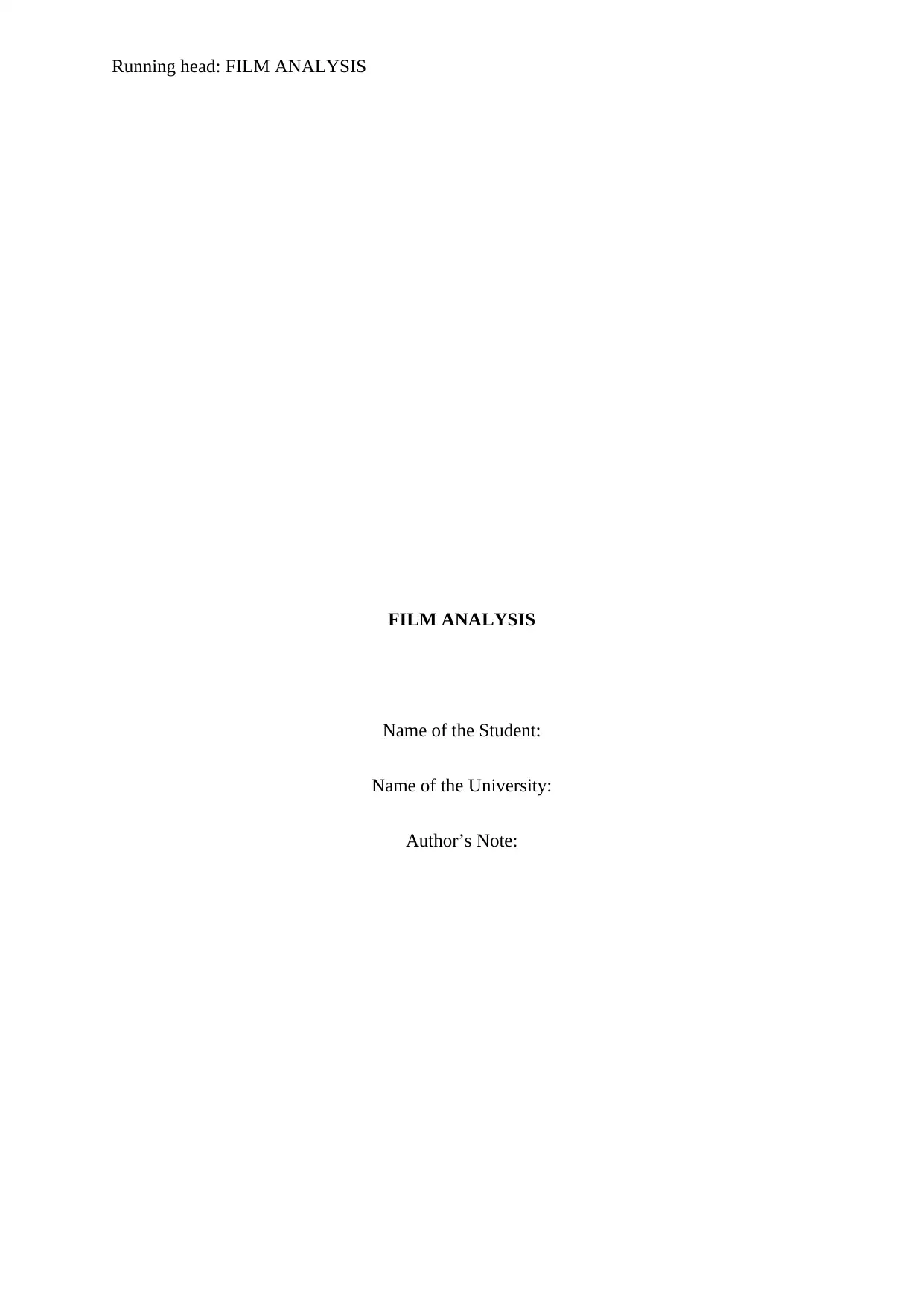
Running head: FILM ANALYSIS
FILM ANALYSIS
Name of the Student:
Name of the University:
Author’s Note:
FILM ANALYSIS
Name of the Student:
Name of the University:
Author’s Note:
Secure Best Marks with AI Grader
Need help grading? Try our AI Grader for instant feedback on your assignments.
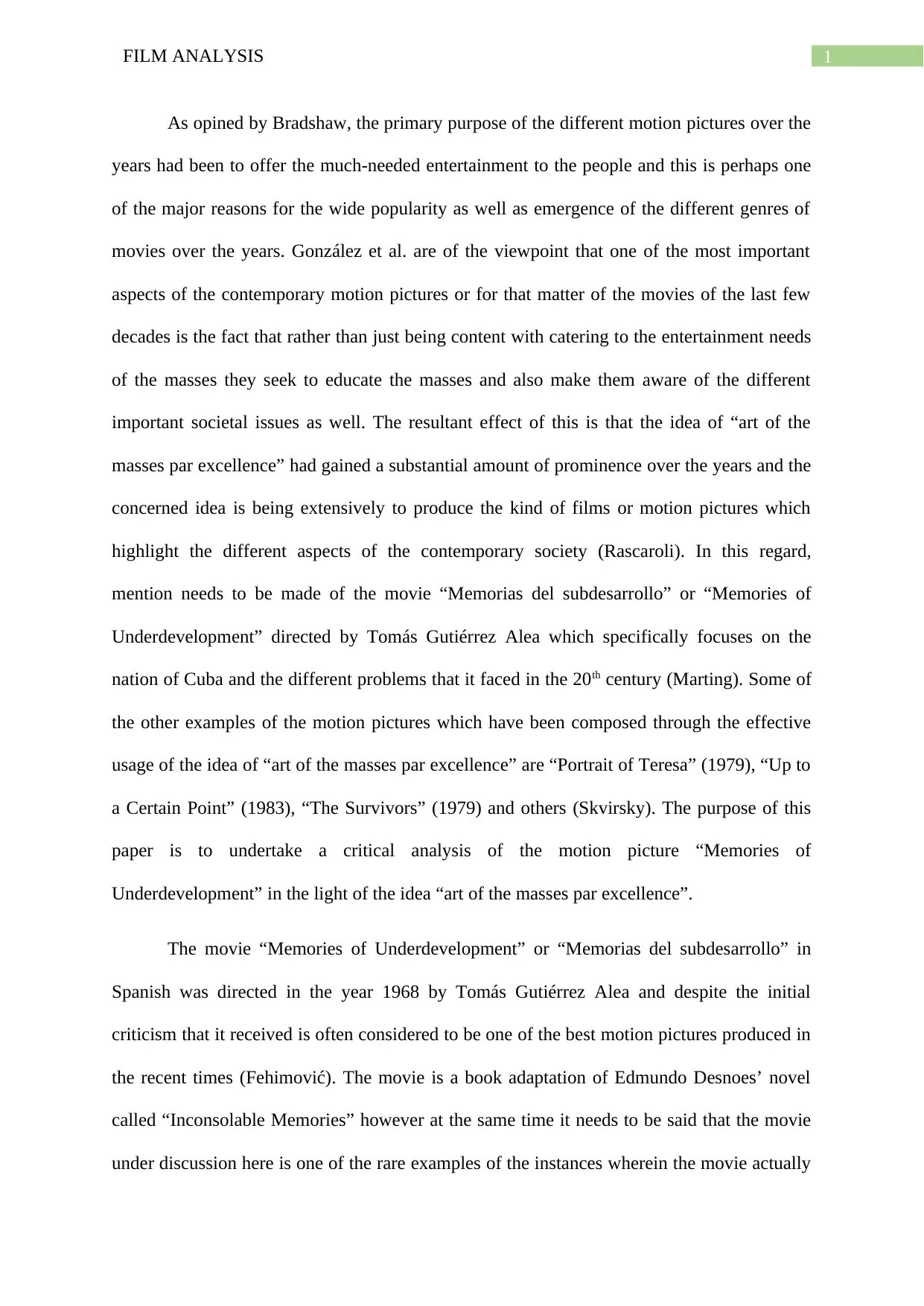
1FILM ANALYSIS
As opined by Bradshaw, the primary purpose of the different motion pictures over the
years had been to offer the much-needed entertainment to the people and this is perhaps one
of the major reasons for the wide popularity as well as emergence of the different genres of
movies over the years. González et al. are of the viewpoint that one of the most important
aspects of the contemporary motion pictures or for that matter of the movies of the last few
decades is the fact that rather than just being content with catering to the entertainment needs
of the masses they seek to educate the masses and also make them aware of the different
important societal issues as well. The resultant effect of this is that the idea of “art of the
masses par excellence” had gained a substantial amount of prominence over the years and the
concerned idea is being extensively to produce the kind of films or motion pictures which
highlight the different aspects of the contemporary society (Rascaroli). In this regard,
mention needs to be made of the movie “Memorias del subdesarrollo” or “Memories of
Underdevelopment” directed by Tomás Gutiérrez Alea which specifically focuses on the
nation of Cuba and the different problems that it faced in the 20th century (Marting). Some of
the other examples of the motion pictures which have been composed through the effective
usage of the idea of “art of the masses par excellence” are “Portrait of Teresa” (1979), “Up to
a Certain Point” (1983), “The Survivors” (1979) and others (Skvirsky). The purpose of this
paper is to undertake a critical analysis of the motion picture “Memories of
Underdevelopment” in the light of the idea “art of the masses par excellence”.
The movie “Memories of Underdevelopment” or “Memorias del subdesarrollo” in
Spanish was directed in the year 1968 by Tomás Gutiérrez Alea and despite the initial
criticism that it received is often considered to be one of the best motion pictures produced in
the recent times (Fehimović). The movie is a book adaptation of Edmundo Desnoes’ novel
called “Inconsolable Memories” however at the same time it needs to be said that the movie
under discussion here is one of the rare examples of the instances wherein the movie actually
As opined by Bradshaw, the primary purpose of the different motion pictures over the
years had been to offer the much-needed entertainment to the people and this is perhaps one
of the major reasons for the wide popularity as well as emergence of the different genres of
movies over the years. González et al. are of the viewpoint that one of the most important
aspects of the contemporary motion pictures or for that matter of the movies of the last few
decades is the fact that rather than just being content with catering to the entertainment needs
of the masses they seek to educate the masses and also make them aware of the different
important societal issues as well. The resultant effect of this is that the idea of “art of the
masses par excellence” had gained a substantial amount of prominence over the years and the
concerned idea is being extensively to produce the kind of films or motion pictures which
highlight the different aspects of the contemporary society (Rascaroli). In this regard,
mention needs to be made of the movie “Memorias del subdesarrollo” or “Memories of
Underdevelopment” directed by Tomás Gutiérrez Alea which specifically focuses on the
nation of Cuba and the different problems that it faced in the 20th century (Marting). Some of
the other examples of the motion pictures which have been composed through the effective
usage of the idea of “art of the masses par excellence” are “Portrait of Teresa” (1979), “Up to
a Certain Point” (1983), “The Survivors” (1979) and others (Skvirsky). The purpose of this
paper is to undertake a critical analysis of the motion picture “Memories of
Underdevelopment” in the light of the idea “art of the masses par excellence”.
The movie “Memories of Underdevelopment” or “Memorias del subdesarrollo” in
Spanish was directed in the year 1968 by Tomás Gutiérrez Alea and despite the initial
criticism that it received is often considered to be one of the best motion pictures produced in
the recent times (Fehimović). The movie is a book adaptation of Edmundo Desnoes’ novel
called “Inconsolable Memories” however at the same time it needs to be said that the movie
under discussion here is one of the rare examples of the instances wherein the movie actually
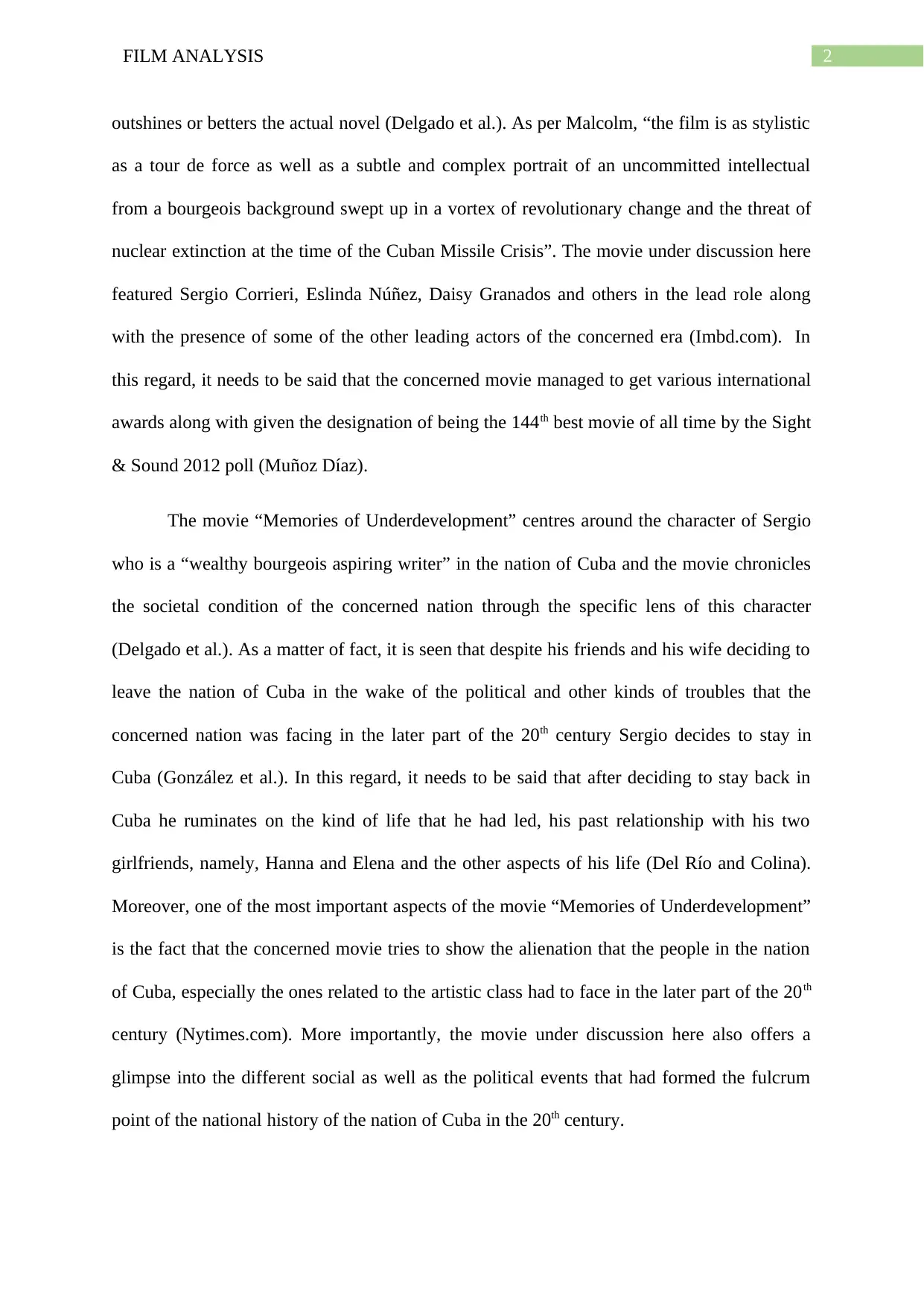
2FILM ANALYSIS
outshines or betters the actual novel (Delgado et al.). As per Malcolm, “the film is as stylistic
as a tour de force as well as a subtle and complex portrait of an uncommitted intellectual
from a bourgeois background swept up in a vortex of revolutionary change and the threat of
nuclear extinction at the time of the Cuban Missile Crisis”. The movie under discussion here
featured Sergio Corrieri, Eslinda Núñez, Daisy Granados and others in the lead role along
with the presence of some of the other leading actors of the concerned era (Imbd.com). In
this regard, it needs to be said that the concerned movie managed to get various international
awards along with given the designation of being the 144th best movie of all time by the Sight
& Sound 2012 poll (Muñoz Díaz).
The movie “Memories of Underdevelopment” centres around the character of Sergio
who is a “wealthy bourgeois aspiring writer” in the nation of Cuba and the movie chronicles
the societal condition of the concerned nation through the specific lens of this character
(Delgado et al.). As a matter of fact, it is seen that despite his friends and his wife deciding to
leave the nation of Cuba in the wake of the political and other kinds of troubles that the
concerned nation was facing in the later part of the 20th century Sergio decides to stay in
Cuba (González et al.). In this regard, it needs to be said that after deciding to stay back in
Cuba he ruminates on the kind of life that he had led, his past relationship with his two
girlfriends, namely, Hanna and Elena and the other aspects of his life (Del Río and Colina).
Moreover, one of the most important aspects of the movie “Memories of Underdevelopment”
is the fact that the concerned movie tries to show the alienation that the people in the nation
of Cuba, especially the ones related to the artistic class had to face in the later part of the 20th
century (Nytimes.com). More importantly, the movie under discussion here also offers a
glimpse into the different social as well as the political events that had formed the fulcrum
point of the national history of the nation of Cuba in the 20th century.
outshines or betters the actual novel (Delgado et al.). As per Malcolm, “the film is as stylistic
as a tour de force as well as a subtle and complex portrait of an uncommitted intellectual
from a bourgeois background swept up in a vortex of revolutionary change and the threat of
nuclear extinction at the time of the Cuban Missile Crisis”. The movie under discussion here
featured Sergio Corrieri, Eslinda Núñez, Daisy Granados and others in the lead role along
with the presence of some of the other leading actors of the concerned era (Imbd.com). In
this regard, it needs to be said that the concerned movie managed to get various international
awards along with given the designation of being the 144th best movie of all time by the Sight
& Sound 2012 poll (Muñoz Díaz).
The movie “Memories of Underdevelopment” centres around the character of Sergio
who is a “wealthy bourgeois aspiring writer” in the nation of Cuba and the movie chronicles
the societal condition of the concerned nation through the specific lens of this character
(Delgado et al.). As a matter of fact, it is seen that despite his friends and his wife deciding to
leave the nation of Cuba in the wake of the political and other kinds of troubles that the
concerned nation was facing in the later part of the 20th century Sergio decides to stay in
Cuba (González et al.). In this regard, it needs to be said that after deciding to stay back in
Cuba he ruminates on the kind of life that he had led, his past relationship with his two
girlfriends, namely, Hanna and Elena and the other aspects of his life (Del Río and Colina).
Moreover, one of the most important aspects of the movie “Memories of Underdevelopment”
is the fact that the concerned movie tries to show the alienation that the people in the nation
of Cuba, especially the ones related to the artistic class had to face in the later part of the 20th
century (Nytimes.com). More importantly, the movie under discussion here also offers a
glimpse into the different social as well as the political events that had formed the fulcrum
point of the national history of the nation of Cuba in the 20th century.
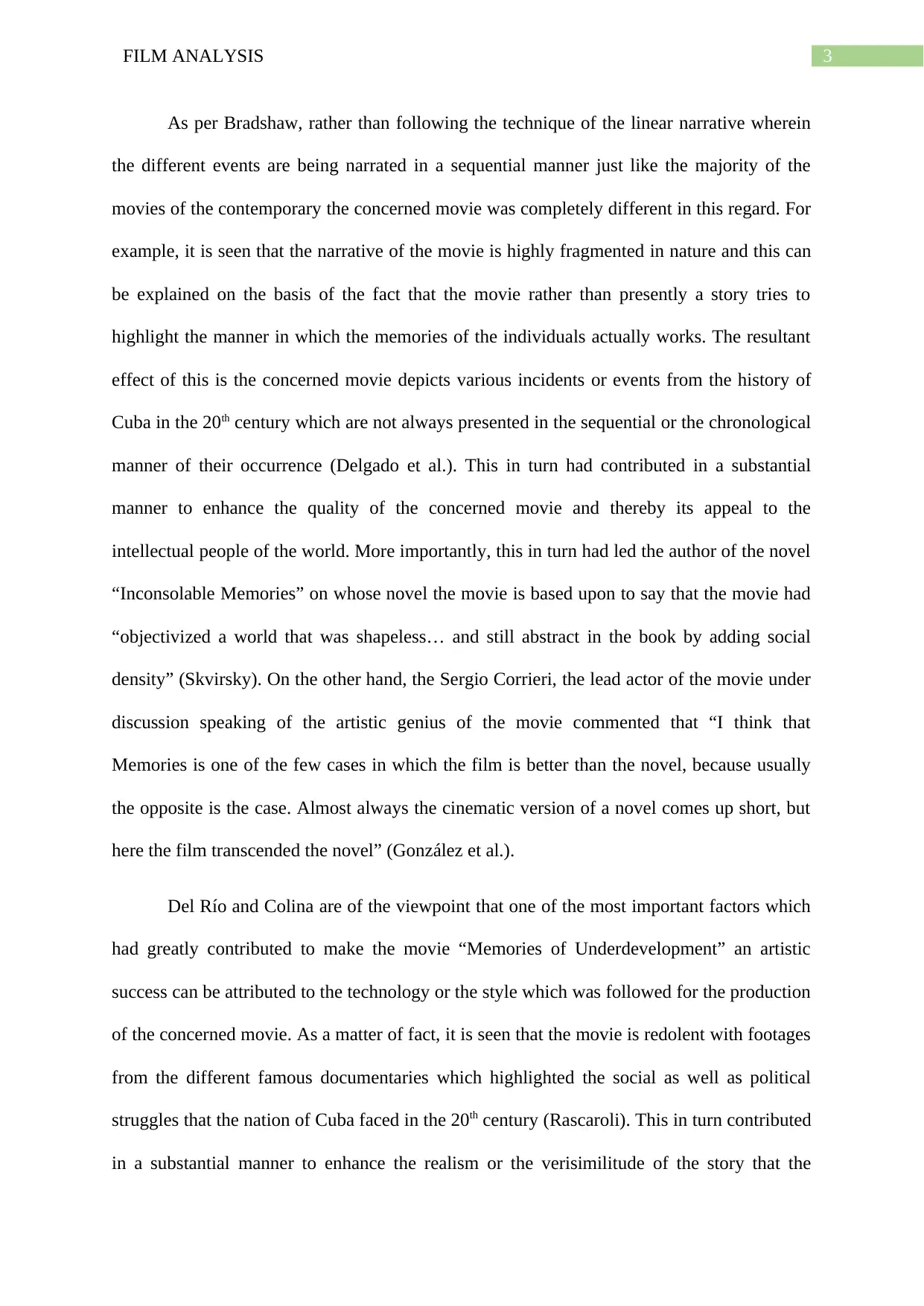
3FILM ANALYSIS
As per Bradshaw, rather than following the technique of the linear narrative wherein
the different events are being narrated in a sequential manner just like the majority of the
movies of the contemporary the concerned movie was completely different in this regard. For
example, it is seen that the narrative of the movie is highly fragmented in nature and this can
be explained on the basis of the fact that the movie rather than presently a story tries to
highlight the manner in which the memories of the individuals actually works. The resultant
effect of this is the concerned movie depicts various incidents or events from the history of
Cuba in the 20th century which are not always presented in the sequential or the chronological
manner of their occurrence (Delgado et al.). This in turn had contributed in a substantial
manner to enhance the quality of the concerned movie and thereby its appeal to the
intellectual people of the world. More importantly, this in turn had led the author of the novel
“Inconsolable Memories” on whose novel the movie is based upon to say that the movie had
“objectivized a world that was shapeless… and still abstract in the book by adding social
density” (Skvirsky). On the other hand, the Sergio Corrieri, the lead actor of the movie under
discussion speaking of the artistic genius of the movie commented that “I think that
Memories is one of the few cases in which the film is better than the novel, because usually
the opposite is the case. Almost always the cinematic version of a novel comes up short, but
here the film transcended the novel” (González et al.).
Del Río and Colina are of the viewpoint that one of the most important factors which
had greatly contributed to make the movie “Memories of Underdevelopment” an artistic
success can be attributed to the technology or the style which was followed for the production
of the concerned movie. As a matter of fact, it is seen that the movie is redolent with footages
from the different famous documentaries which highlighted the social as well as political
struggles that the nation of Cuba faced in the 20th century (Rascaroli). This in turn contributed
in a substantial manner to enhance the realism or the verisimilitude of the story that the
As per Bradshaw, rather than following the technique of the linear narrative wherein
the different events are being narrated in a sequential manner just like the majority of the
movies of the contemporary the concerned movie was completely different in this regard. For
example, it is seen that the narrative of the movie is highly fragmented in nature and this can
be explained on the basis of the fact that the movie rather than presently a story tries to
highlight the manner in which the memories of the individuals actually works. The resultant
effect of this is the concerned movie depicts various incidents or events from the history of
Cuba in the 20th century which are not always presented in the sequential or the chronological
manner of their occurrence (Delgado et al.). This in turn had contributed in a substantial
manner to enhance the quality of the concerned movie and thereby its appeal to the
intellectual people of the world. More importantly, this in turn had led the author of the novel
“Inconsolable Memories” on whose novel the movie is based upon to say that the movie had
“objectivized a world that was shapeless… and still abstract in the book by adding social
density” (Skvirsky). On the other hand, the Sergio Corrieri, the lead actor of the movie under
discussion speaking of the artistic genius of the movie commented that “I think that
Memories is one of the few cases in which the film is better than the novel, because usually
the opposite is the case. Almost always the cinematic version of a novel comes up short, but
here the film transcended the novel” (González et al.).
Del Río and Colina are of the viewpoint that one of the most important factors which
had greatly contributed to make the movie “Memories of Underdevelopment” an artistic
success can be attributed to the technology or the style which was followed for the production
of the concerned movie. As a matter of fact, it is seen that the movie is redolent with footages
from the different famous documentaries which highlighted the social as well as political
struggles that the nation of Cuba faced in the 20th century (Rascaroli). This in turn contributed
in a substantial manner to enhance the realism or the verisimilitude of the story that the
Secure Best Marks with AI Grader
Need help grading? Try our AI Grader for instant feedback on your assignments.
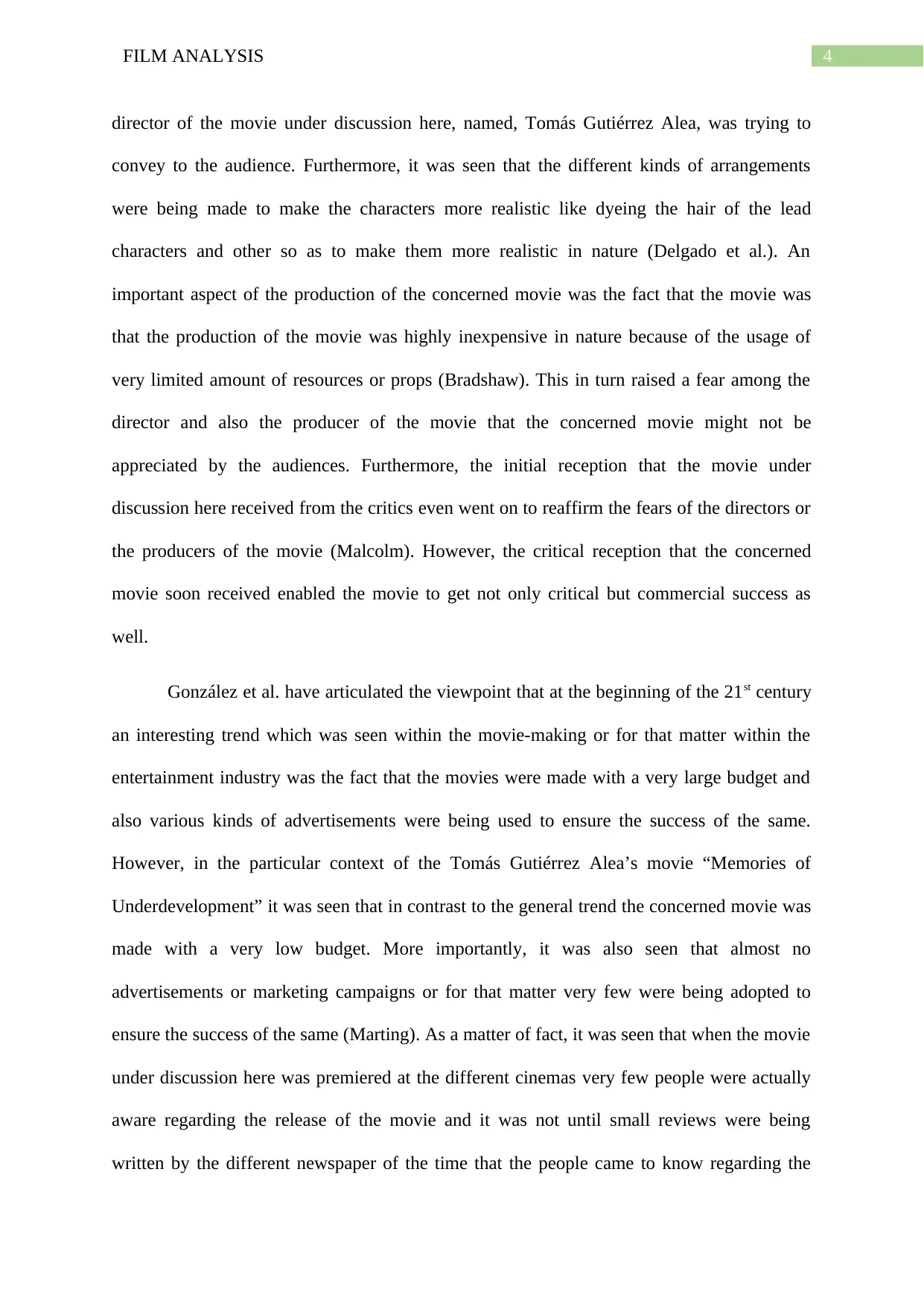
4FILM ANALYSIS
director of the movie under discussion here, named, Tomás Gutiérrez Alea, was trying to
convey to the audience. Furthermore, it was seen that the different kinds of arrangements
were being made to make the characters more realistic like dyeing the hair of the lead
characters and other so as to make them more realistic in nature (Delgado et al.). An
important aspect of the production of the concerned movie was the fact that the movie was
that the production of the movie was highly inexpensive in nature because of the usage of
very limited amount of resources or props (Bradshaw). This in turn raised a fear among the
director and also the producer of the movie that the concerned movie might not be
appreciated by the audiences. Furthermore, the initial reception that the movie under
discussion here received from the critics even went on to reaffirm the fears of the directors or
the producers of the movie (Malcolm). However, the critical reception that the concerned
movie soon received enabled the movie to get not only critical but commercial success as
well.
González et al. have articulated the viewpoint that at the beginning of the 21st century
an interesting trend which was seen within the movie-making or for that matter within the
entertainment industry was the fact that the movies were made with a very large budget and
also various kinds of advertisements were being used to ensure the success of the same.
However, in the particular context of the Tomás Gutiérrez Alea’s movie “Memories of
Underdevelopment” it was seen that in contrast to the general trend the concerned movie was
made with a very low budget. More importantly, it was also seen that almost no
advertisements or marketing campaigns or for that matter very few were being adopted to
ensure the success of the same (Marting). As a matter of fact, it was seen that when the movie
under discussion here was premiered at the different cinemas very few people were actually
aware regarding the release of the movie and it was not until small reviews were being
written by the different newspaper of the time that the people came to know regarding the
director of the movie under discussion here, named, Tomás Gutiérrez Alea, was trying to
convey to the audience. Furthermore, it was seen that the different kinds of arrangements
were being made to make the characters more realistic like dyeing the hair of the lead
characters and other so as to make them more realistic in nature (Delgado et al.). An
important aspect of the production of the concerned movie was the fact that the movie was
that the production of the movie was highly inexpensive in nature because of the usage of
very limited amount of resources or props (Bradshaw). This in turn raised a fear among the
director and also the producer of the movie that the concerned movie might not be
appreciated by the audiences. Furthermore, the initial reception that the movie under
discussion here received from the critics even went on to reaffirm the fears of the directors or
the producers of the movie (Malcolm). However, the critical reception that the concerned
movie soon received enabled the movie to get not only critical but commercial success as
well.
González et al. have articulated the viewpoint that at the beginning of the 21st century
an interesting trend which was seen within the movie-making or for that matter within the
entertainment industry was the fact that the movies were made with a very large budget and
also various kinds of advertisements were being used to ensure the success of the same.
However, in the particular context of the Tomás Gutiérrez Alea’s movie “Memories of
Underdevelopment” it was seen that in contrast to the general trend the concerned movie was
made with a very low budget. More importantly, it was also seen that almost no
advertisements or marketing campaigns or for that matter very few were being adopted to
ensure the success of the same (Marting). As a matter of fact, it was seen that when the movie
under discussion here was premiered at the different cinemas very few people were actually
aware regarding the release of the movie and it was not until small reviews were being
written by the different newspaper of the time that the people came to know regarding the
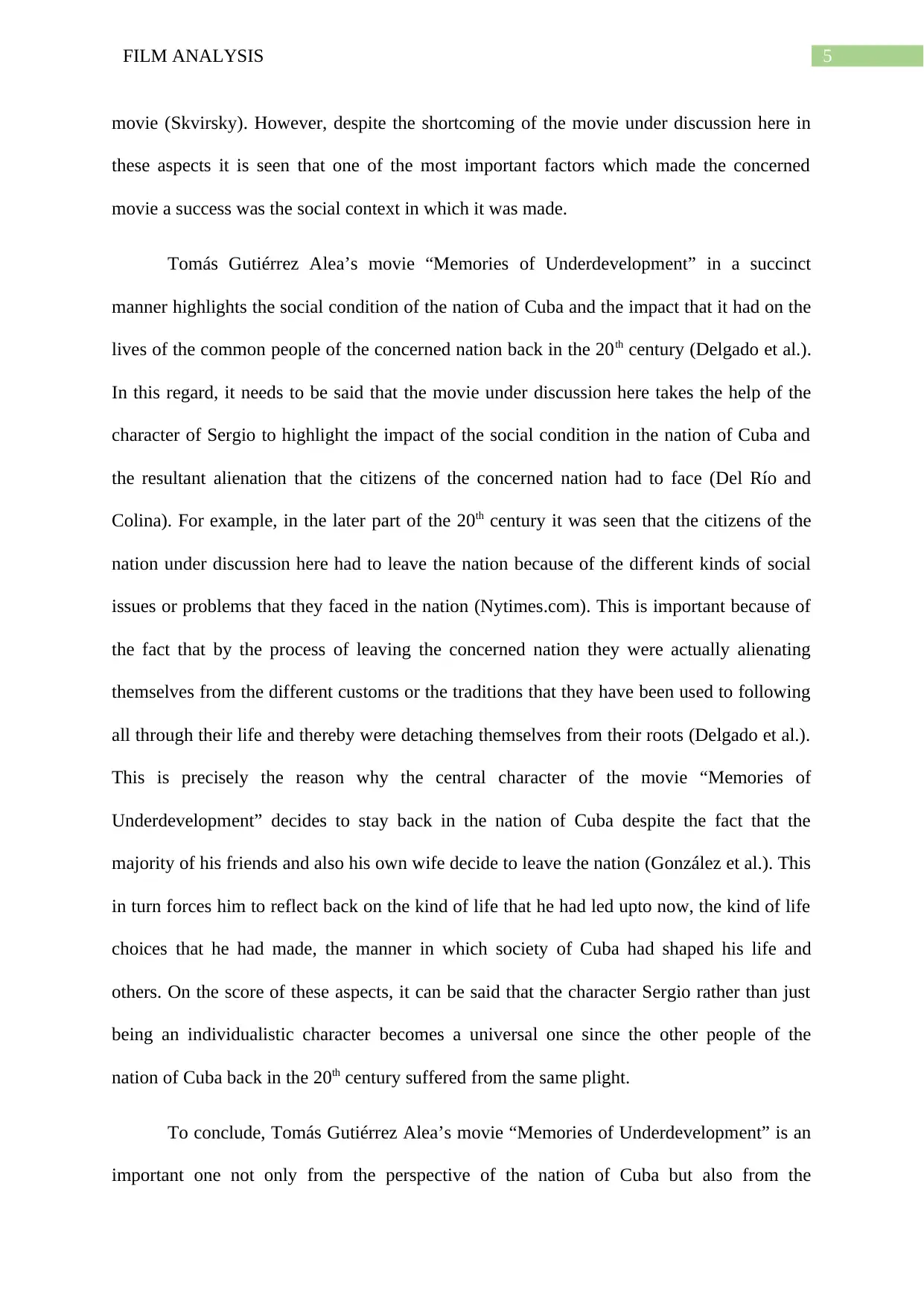
5FILM ANALYSIS
movie (Skvirsky). However, despite the shortcoming of the movie under discussion here in
these aspects it is seen that one of the most important factors which made the concerned
movie a success was the social context in which it was made.
Tomás Gutiérrez Alea’s movie “Memories of Underdevelopment” in a succinct
manner highlights the social condition of the nation of Cuba and the impact that it had on the
lives of the common people of the concerned nation back in the 20th century (Delgado et al.).
In this regard, it needs to be said that the movie under discussion here takes the help of the
character of Sergio to highlight the impact of the social condition in the nation of Cuba and
the resultant alienation that the citizens of the concerned nation had to face (Del Río and
Colina). For example, in the later part of the 20th century it was seen that the citizens of the
nation under discussion here had to leave the nation because of the different kinds of social
issues or problems that they faced in the nation (Nytimes.com). This is important because of
the fact that by the process of leaving the concerned nation they were actually alienating
themselves from the different customs or the traditions that they have been used to following
all through their life and thereby were detaching themselves from their roots (Delgado et al.).
This is precisely the reason why the central character of the movie “Memories of
Underdevelopment” decides to stay back in the nation of Cuba despite the fact that the
majority of his friends and also his own wife decide to leave the nation (González et al.). This
in turn forces him to reflect back on the kind of life that he had led upto now, the kind of life
choices that he had made, the manner in which society of Cuba had shaped his life and
others. On the score of these aspects, it can be said that the character Sergio rather than just
being an individualistic character becomes a universal one since the other people of the
nation of Cuba back in the 20th century suffered from the same plight.
To conclude, Tomás Gutiérrez Alea’s movie “Memories of Underdevelopment” is an
important one not only from the perspective of the nation of Cuba but also from the
movie (Skvirsky). However, despite the shortcoming of the movie under discussion here in
these aspects it is seen that one of the most important factors which made the concerned
movie a success was the social context in which it was made.
Tomás Gutiérrez Alea’s movie “Memories of Underdevelopment” in a succinct
manner highlights the social condition of the nation of Cuba and the impact that it had on the
lives of the common people of the concerned nation back in the 20th century (Delgado et al.).
In this regard, it needs to be said that the movie under discussion here takes the help of the
character of Sergio to highlight the impact of the social condition in the nation of Cuba and
the resultant alienation that the citizens of the concerned nation had to face (Del Río and
Colina). For example, in the later part of the 20th century it was seen that the citizens of the
nation under discussion here had to leave the nation because of the different kinds of social
issues or problems that they faced in the nation (Nytimes.com). This is important because of
the fact that by the process of leaving the concerned nation they were actually alienating
themselves from the different customs or the traditions that they have been used to following
all through their life and thereby were detaching themselves from their roots (Delgado et al.).
This is precisely the reason why the central character of the movie “Memories of
Underdevelopment” decides to stay back in the nation of Cuba despite the fact that the
majority of his friends and also his own wife decide to leave the nation (González et al.). This
in turn forces him to reflect back on the kind of life that he had led upto now, the kind of life
choices that he had made, the manner in which society of Cuba had shaped his life and
others. On the score of these aspects, it can be said that the character Sergio rather than just
being an individualistic character becomes a universal one since the other people of the
nation of Cuba back in the 20th century suffered from the same plight.
To conclude, Tomás Gutiérrez Alea’s movie “Memories of Underdevelopment” is an
important one not only from the perspective of the nation of Cuba but also from the
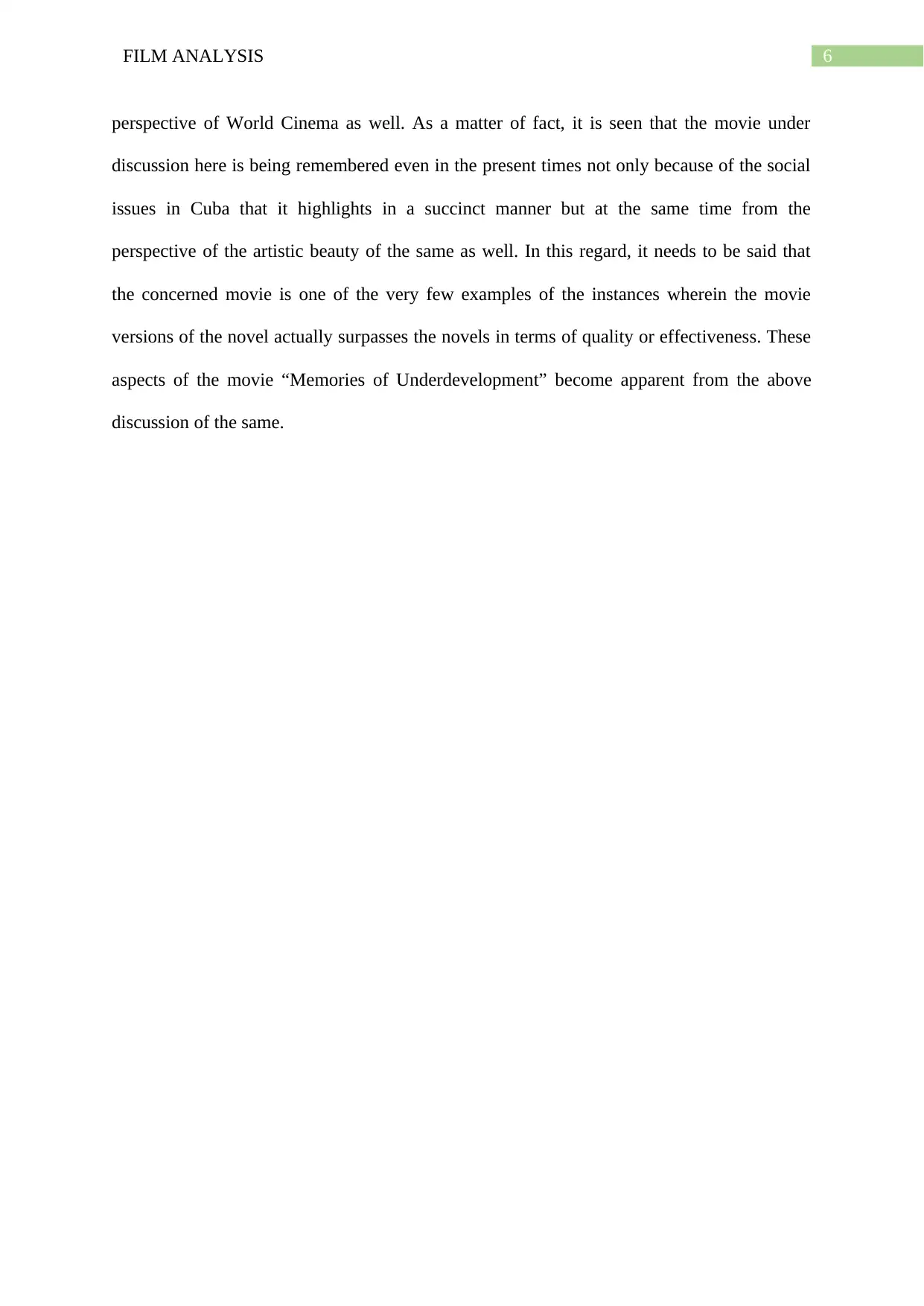
6FILM ANALYSIS
perspective of World Cinema as well. As a matter of fact, it is seen that the movie under
discussion here is being remembered even in the present times not only because of the social
issues in Cuba that it highlights in a succinct manner but at the same time from the
perspective of the artistic beauty of the same as well. In this regard, it needs to be said that
the concerned movie is one of the very few examples of the instances wherein the movie
versions of the novel actually surpasses the novels in terms of quality or effectiveness. These
aspects of the movie “Memories of Underdevelopment” become apparent from the above
discussion of the same.
perspective of World Cinema as well. As a matter of fact, it is seen that the movie under
discussion here is being remembered even in the present times not only because of the social
issues in Cuba that it highlights in a succinct manner but at the same time from the
perspective of the artistic beauty of the same as well. In this regard, it needs to be said that
the concerned movie is one of the very few examples of the instances wherein the movie
versions of the novel actually surpasses the novels in terms of quality or effectiveness. These
aspects of the movie “Memories of Underdevelopment” become apparent from the above
discussion of the same.
Paraphrase This Document
Need a fresh take? Get an instant paraphrase of this document with our AI Paraphraser
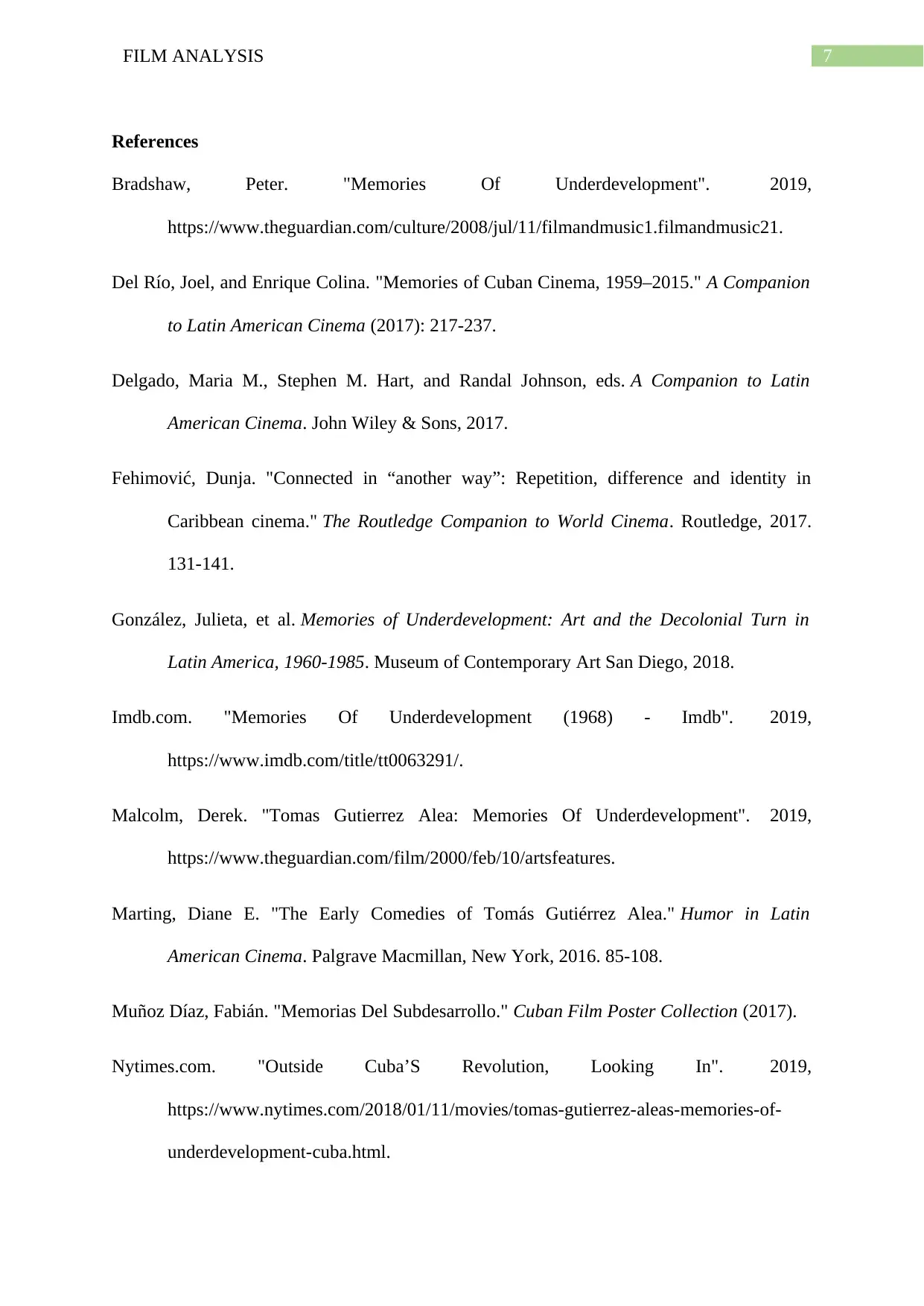
7FILM ANALYSIS
References
Bradshaw, Peter. "Memories Of Underdevelopment". 2019,
https://www.theguardian.com/culture/2008/jul/11/filmandmusic1.filmandmusic21.
Del Río, Joel, and Enrique Colina. "Memories of Cuban Cinema, 1959–2015." A Companion
to Latin American Cinema (2017): 217-237.
Delgado, Maria M., Stephen M. Hart, and Randal Johnson, eds. A Companion to Latin
American Cinema. John Wiley & Sons, 2017.
Fehimović, Dunja. "Connected in “another way”: Repetition, difference and identity in
Caribbean cinema." The Routledge Companion to World Cinema. Routledge, 2017.
131-141.
González, Julieta, et al. Memories of Underdevelopment: Art and the Decolonial Turn in
Latin America, 1960-1985. Museum of Contemporary Art San Diego, 2018.
Imdb.com. "Memories Of Underdevelopment (1968) - Imdb". 2019,
https://www.imdb.com/title/tt0063291/.
Malcolm, Derek. "Tomas Gutierrez Alea: Memories Of Underdevelopment". 2019,
https://www.theguardian.com/film/2000/feb/10/artsfeatures.
Marting, Diane E. "The Early Comedies of Tomás Gutiérrez Alea." Humor in Latin
American Cinema. Palgrave Macmillan, New York, 2016. 85-108.
Muñoz Díaz, Fabián. "Memorias Del Subdesarrollo." Cuban Film Poster Collection (2017).
Nytimes.com. "Outside Cuba’S Revolution, Looking In". 2019,
https://www.nytimes.com/2018/01/11/movies/tomas-gutierrez-aleas-memories-of-
underdevelopment-cuba.html.
References
Bradshaw, Peter. "Memories Of Underdevelopment". 2019,
https://www.theguardian.com/culture/2008/jul/11/filmandmusic1.filmandmusic21.
Del Río, Joel, and Enrique Colina. "Memories of Cuban Cinema, 1959–2015." A Companion
to Latin American Cinema (2017): 217-237.
Delgado, Maria M., Stephen M. Hart, and Randal Johnson, eds. A Companion to Latin
American Cinema. John Wiley & Sons, 2017.
Fehimović, Dunja. "Connected in “another way”: Repetition, difference and identity in
Caribbean cinema." The Routledge Companion to World Cinema. Routledge, 2017.
131-141.
González, Julieta, et al. Memories of Underdevelopment: Art and the Decolonial Turn in
Latin America, 1960-1985. Museum of Contemporary Art San Diego, 2018.
Imdb.com. "Memories Of Underdevelopment (1968) - Imdb". 2019,
https://www.imdb.com/title/tt0063291/.
Malcolm, Derek. "Tomas Gutierrez Alea: Memories Of Underdevelopment". 2019,
https://www.theguardian.com/film/2000/feb/10/artsfeatures.
Marting, Diane E. "The Early Comedies of Tomás Gutiérrez Alea." Humor in Latin
American Cinema. Palgrave Macmillan, New York, 2016. 85-108.
Muñoz Díaz, Fabián. "Memorias Del Subdesarrollo." Cuban Film Poster Collection (2017).
Nytimes.com. "Outside Cuba’S Revolution, Looking In". 2019,
https://www.nytimes.com/2018/01/11/movies/tomas-gutierrez-aleas-memories-of-
underdevelopment-cuba.html.

8FILM ANALYSIS
Rascaroli, Laura. "The Idea of Essay Film." The Essay Film: Dialogue, Politics,
Utopia (2016): 300.
Skvirsky, Salomé Aguilera. "Realism, documentary, and the process genre in early New
Latin American Cinema." The Routledge Companion to Latin American Cinema.
Routledge, 2017. 119-132.
Rascaroli, Laura. "The Idea of Essay Film." The Essay Film: Dialogue, Politics,
Utopia (2016): 300.
Skvirsky, Salomé Aguilera. "Realism, documentary, and the process genre in early New
Latin American Cinema." The Routledge Companion to Latin American Cinema.
Routledge, 2017. 119-132.
1 out of 9
Your All-in-One AI-Powered Toolkit for Academic Success.
+13062052269
info@desklib.com
Available 24*7 on WhatsApp / Email
![[object Object]](/_next/static/media/star-bottom.7253800d.svg)
Unlock your academic potential
© 2024 | Zucol Services PVT LTD | All rights reserved.